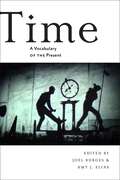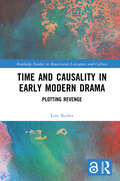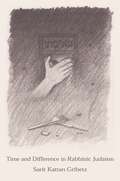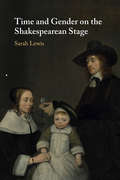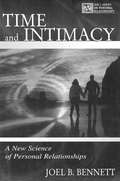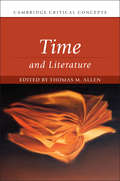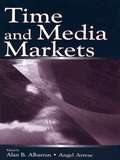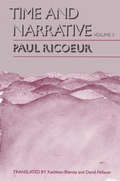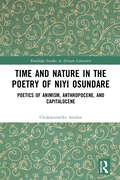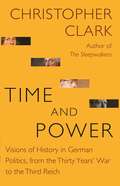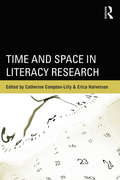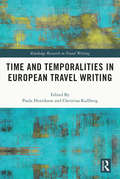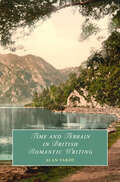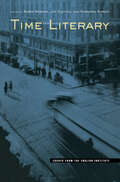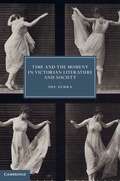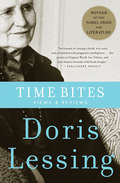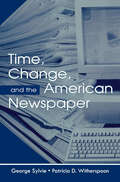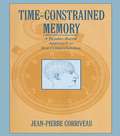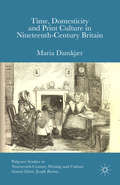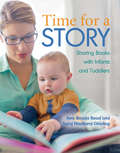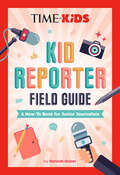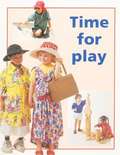- Table View
- List View
Timaeus of Tauromenium and Hellenistic Historiography
by Christopher A. BaronTimaeus of Tauromenium (350-260 BC) wrote the authoritative account of the Greeks in the Western Mediterranean. Like almost all the Hellenistic historians, his work survives only in fragments. Beyond an up-to-date treatment of this important author, this book shows that both the nature of the evidence and modern assumptions about historical writing in the Hellenistic period have skewed our treatment and judgement of lost historians. For Timaeus, much of our evidence is preserved in the polemical context of Polybius' Book 12. When we move outside that framework and examine the fragments of Timaeus in their proper context, we gain a greater appreciation for his method and his achievement, including his use of polemical invective and his composition of speeches. This examination of Timaeus also conveys a broader impression of the major lines of Hellenistic historiography.
Time: A Vocabulary of the Present
by Joel Burges Amy J. EliasThe critical condition and historical motivation behind Time Studies The concept of time in the post-millennial age is undergoing a radical rethinking within the humanities. Time: A Vocabulary of the Present newly theorizes our experiences of time in relation to developments in post-1945 cultural theory and arts practices. Wide ranging and theoretically provocative, the volume introduces readers to cutting-edge temporal conceptualizations and investigates what exactly constitutes the scope of time studies.Featuring twenty essays that reveal what we talk about when we talk about time today, especially in the areas of history, measurement, and culture, each essay pairs two keywords to explore the tension and nuances between them, from “past/future” and “anticipation/unexpected” to “extinction/adaptation” and “serial/simultaneous.” Moving beyond the truisms of postmodernism, the collection newly theorizes the meanings of temporality in relationship to aesthetic, cultural, technological, and economic developments in the postwar period. This book thus assumes that time—not space, as the postmoderns had it—is central to the contemporary period, and that through it we can come to terms with what contemporaneity can be for human beings caught up in the historical present. In the end, Time reveals that the present is a cultural matrix in which overlapping temporalities condition and compete for our attention. Thus each pair of terms presents two temporalities, yielding a generative account of the time, or times, in which we live.
Time and Causality in Early Modern Drama: Plotting Revenge (Routledge Studies in Renaissance Literature and Culture)
by Linc KeslerThe opening of the first commercial theatre in London in 1579 initiated a pattern of development that radically reshaped representation. The competition among theatres required the constant production of new works, creating an interplay between the innovations of producers and the rapidly changing perceptions of audiences. The result was a process of incremental change that redefined perceptions of time, action, and identity. Aristotle in the Poetics contrasted a similar set of formal developments to the earlier system of the epics, which, like many predecessors of early modern drama, had emerged from largely oral traditions. Located in the context of contemporary relations between the academy and Indigenous communities, Time and Causality in Early Modern Drama: Plotting Revenge traces these developments through changes in the revenge tragedy form and questions our abilities, habituated to literacy, to fully understand or appreciate the complexity and operations of oral systems.The Open Access version of this book, available at http://www.taylorfrancis.com, has been made available under a Creative Commons [Attribution-Non Commercial-No Derivatives (CC-BY-NC-ND)] 4.0 license.
Time and Difference in Rabbinic Judaism
by Professor Sarit Kattan GribetzHow the rabbis of late antiquity used time to define the boundaries of Jewish identityThe rabbinic corpus begins with a question–“when?”—and is brimming with discussions about time and the relationship between people, God, and the hour. Time and Difference in Rabbinic Judaism explores the rhythms of time that animated the rabbinic world of late antiquity, revealing how rabbis conceptualized time as a way of constructing difference between themselves and imperial Rome, Jews and Christians, men and women, and human and divine.In each chapter, Sarit Kattan Gribetz explores a unique aspect of rabbinic discourse on time. She shows how the ancient rabbinic texts artfully subvert Roman imperialism by offering "rabbinic time" as an alternative to "Roman time." She examines rabbinic discourse about the Sabbath, demonstrating how the weekly day of rest marked "Jewish time" from "Christian time." Gribetz looks at gendered daily rituals, showing how rabbis created "men's time" and "women's time" by mandating certain rituals for men and others for women. She delves into rabbinic writings that reflect on how God spends time and how God's use of time relates to human beings, merging "divine time" with "human time." Finally, she traces the legacies of rabbinic constructions of time in the medieval and modern periods.Time and Difference in Rabbinic Judaism sheds new light on the central role that time played in the construction of Jewish identity, subjectivity, and theology during this transformative period in the history of Judaism.
Time and Gender on the Shakespearean Stage
by Sarah LewisThis book analyses the cultural and theatrical intersections of early modern temporal concepts and gendered identities. Through close readings of the works of Shakespeare, Middleton, Dekker, Heywood and others, across the genres of domestic comedy, city comedy and revenge tragedy, Sarah Lewis shows how temporal tropes are used to delineate masculinity and femininity on the early modern stage, and vice versa. She sets out the ways in which the temporal constructs of patience, prodigality and revenge, as well as the dramatic identities that are built from those constructs, and the experience of playgoing itself, negotiate a fraught opposition between action in the moment and delay in the duration. This book argues that looking at time through the lens of gender, and gender through the lens of time, is crucial if we are to develop our understanding of the early modern cultural construction of both.
Time and Intimacy: A New Science of Personal Relationships (LEA's Series on Personal Relationships)
by Joel B. BennettThere is a mysterious connection between our experiences of intimacy--of love, the longing to feel connected, and sexual embrace--and the human sense of time--eternity, impermanence, and rhythm. In this critical analysis of the time-intimacy equation, Bennett shows how the scientific study of personal relationships can address this mystery. As a study of transpersonal science, this book points to the possible evolution of intimacy and of our consciousness of time, and how the two evolutionary paths weave together. Dr. Bennett draws from a wide array of resources to advance and marry two compelling themes: first, the social and clinical science of personal relationships should integrate the spiritual or transpersonal dimension of intimacy, and second, science can contribute to lay understandings by describing the richly temporal aspects of relationships. In blending popular literature, transpersonal psychology, and scientific research and theory, this work also attempts to address the lack of dialogue between academics who study personal intimacy and those writers in the popular press who give advice and guidelines for building intimacy. Time and Intimacy is written for a broad audience, intended for those with a general interest in relationships, as well as for students, counselors, and psychologists. It can be used as a text in courses on personal relationships, as well as to supplement courses in humanistic psychology, transpersonal psychology, interpersonal communication, relationships, marital and family counseling, human relations, and related areas. Because it advances an interdisciplinary understanding of personal relationships, this book is certain to challenge prevailing views about the meaning of intimacy in both the academic and popular literatures.
Time and Literature (Cambridge Critical Concepts )
by Thomas M. AllenTime and Literature features twenty essays on topics from aesthetics and narratology to globalization and queer temporalities and showcases how time studies, often referred to as “the temporal turn,” cuts across and illuminates research in every field of literature, as well as interdisciplinary approaches drawing on history, philosophy, anthropology, and the natural sciences. Part I, “Origins,” addresses fundamental issues that can be traced back to the beginnings of literary criticism, while Part II, “Development,” shows how thinking about time has been crucial to various interpretive revolutions that have affected literary theory. Part III, “Application,” illustrates the centrality of temporal theorizing to literary criticism in a variety of contemporary approaches, from ecocriticism and new materialisms to media and archive studies. The first anthology to provide a synthesis of recent scholarship on the temporality of literary language from across different national and historical periods, Time and Literature will appeal to academic researchers and interested laypersons alike.
Time and Media Markets (Routledge Communication Series)
by Alan B. Albarran Angel Arrese RecaThis edited collection examines time and its relationship to and impact upon media industries, studying how the media industry views time and makes business and economic decisions based on considerations of time. Contributions from an international set of authors analyze time constraints and competition between different media; the quantity and quality of time spent in media consumption, audience and readership time valuation/costing/pricing; and the emergence of new media businesses around individual time management. Specific topics examined in the volume include: * a philosophical look at the concept of time and its application to media markets; * temporal aspects of media distribution for the media industries, and how time affects their activities; * the impact of increasing media industry consolidation and convergence on managerial effectiveness; * approaches to time by CNN and its various cache of news channels, in a managerial context; * the application of niche theory as a framework to examine competition between the Internet and television; * Internet access in the United Kingdom and Europe, examining the cost of time for online access; * the exchange of time and money in the television market for advertising; and * a summary of research and an agenda for future research on the topic of time's role in the media industry and markets. With its origins in the third World Media Economics conference, held in 2000, Time and Media Markets is a distinctive and important collection appropriate for scholars and advanced students in media management and economics.
Time and Narrative: Volume 3
by Paul Ricoeur translated by Kathleen Blamey David PellauerIn the first two volumes of this work, Paul Ricoeur examined the relations between time and narrative in historical writing, fiction, and theories of literature. This final volume, a comprehensive reexamination and synthesis of the ideas developed in volumes 1 and 2, stands as Ricoeur's most complete and satisfying presentation of his own philosophy. Ricoeur's aim here is to explicate as fully as possible the hypothesis that has governed his inquiry, namely, that the effort of thinking at work in every narrative configuration is completed in a refiguration of temporal experience. To this end, he sets himself the central task of determing how far a poetics of narrative can be said to resolve the aporias--the doubtful or problematic elements--of time. Chief among these aporias are the conflicts between the phenomenological sense of time (that experienced or lived by the individual) and the cosmological sense (that described by history and physics) on the one hand and the oneness or unitary nature of time on the other. In conclusion, Ricoeur reflects upon the inscrutability of time itself and attempts to discern the limits of his own examination of narrative discourse. As in his previous works, Ricoeur labors as an imcomparable mediator of often estranged philosophical approaches, always in a manner that compromises neither rigor nor creativity. --Mark Kline Taylor, Christian Century In the midst of two opposing contemporary options--either to flee into ever more precious readings . . . or to retreat into ever more safe readings . . . --Ricoeur's work offers an alternative option that is critical, wide-ranging, and conducive to new applications. --Mary Gerhart, Journalof Religion
Time and Narrative in Ancient Historiography
by Jonas Grethlein Christopher B. KrebsHistorians often refer to past events which took place prior to their narrative's proper past- that is, they refer to a 'plupast'. This past embedded in the past can be evoked by characters as well as by the historian in his own voice. It can bring into play other texts, but can also draw on lieux de mémoire or on material objects. The articles assembled in this volume explore the manifold forms of the plupast in Greek and Roman historians from Herodotus to Appian. The authors demonstrate that the plupast is a powerful tool for the creation of historical meaning. Moreover, the acts of memory embedded in the historical narrative parallel to some degree the historian's activity of recording the past. The plupast thereby allows Greek and Roman historians to reflect on how (not) to write history and gains metahistorical significance. In shedding new light on the temporal complexity and the subtle forms of self-conscious reflection in the works of ancient historians, Time and Narrative in Ancient Historiography significantly enhances our understanding of their narrative art.
Time and Nature in the Poetry of Niyi Osundare: Poetics of Animism, Anthropocene, and Capitalocene (Routledge Studies in African Literature)
by Chukwunwike AnolueThis book provides an ecocritical analysis of the poetry of the famous Nigerian poet Niyi Osundare. It interrogates the intricate interface between time and nature in 11 of Osundare’s defining poetry collections. This is a book of postcolonial ecocriticism from an African perspective. It brings together the ecocritical theory of animism and theories of geologic time in the discussion of Osundare’s poetry. Osundare shows that animism has a lot to offer in enriching human understanding of the ecosystem. And while he eloquently catalogues problems undermining the health of the earth in this age of the Anthropocene and the Capitalocene in his poetry, he also holds on to the hope of a better future. The book concludes that Osundare’s optimism is what informs his use of poetry to press humankind to rise to the duty of salvaging the environment. Deploying an interdisciplinary approach that stretches across the fields of literature, religion, geology, physics, economics, and anthropology, this book will be an important read for those looking for fresh ways to understand Osundare’s poetry and African nature writing.
Time and Power: Visions of History in German Politics, from the Thirty Years' War to the Third Reich (The\lawrence Stone Lectures #11)
by Christopher ClarkFrom the author of the national bestseller The Sleepwalkers, a book about how the exercise of power is shaped by different concepts of timeThis groundbreaking book presents new perspectives on how the exercise of power is shaped by different notions of time. Acclaimed historian Christopher Clark draws on four key figures from German history—Friedrich Wilhelm of Brandenburg-Prussia, Frederick the Great, Otto von Bismarck, and Adolf Hitler—to look at history through a temporal lens and ask how historical actors and their regimes embody unique conceptions of time.Inspired by the insights of Reinhart Koselleck and François Hartog, two pioneers of the “temporal turn” in historiography, Clark shows how Friedrich Wilhelm rejected the notion of continuity with the past, believing instead that a sovereign must liberate the state from the entanglements of tradition to choose freely among different possible futures. He demonstrates how Frederick the Great abandoned this paradigm for a neoclassical vision of history in which sovereign and state transcend time altogether, and how Bismarck believed that the statesman’s duty was to preserve the timeless permanence of the state amid the torrent of historical change. Clark describes how Hitler did not seek to revolutionize history like Stalin and Mussolini, but instead sought to evade history altogether, emphasizing timeless racial archetypes and a prophetically foretold future.Elegantly written and boldly innovative, Time and Power takes readers from the Thirty Years’ War to the fall of the Third Reich, revealing the connection between political power and the distinct temporalities of the leaders who wield it.
Time and Space in Literacy Research
by Catherine Compton-Lilly Erica HalversonLiteracy researchers interested in how specific sites of learning situate students and the ways they make sense of their worlds are asking new questions and thinking in new ways about how time and space operate as contextual dimensions in the learning lives of students, teachers, and families. These investigations inform questions related to history, identity, methodology, in-school and out-of school spaces, and local/global literacies. An engaging blend of methodological, theoretical, and empirical work featuring well-known researchers on the topic, this book provides a conceptual framework for extending existing conceptions of context and provides unique and ground-breaking examples of empirical research.
Time and Temporalities in European Travel Writing (Routledge Research in Travel Writing)
by Paula Henrikson Christina KullbergThis book is a collective effort to investigate and problematise notions of time and temporality in European travel writing from the late medieval period up to the late nineteenth century. It brings together nine researchers in European travel writing and covers a wide range of areas, travel genres, and languages, coherently integrated around the central theme of time and temporalities. Taken together, the contributions consider how temporal aspects evolve and change in regard to spatial, historical, and literary contexts. In a chapter-by-chapter account this volume thus offers various case studies that address the issue of temporality by showing, for example, how time is inscribed in landscape, how travellers’ encounters with other temporalities informed other disciplines; it interrogates the idea of "cultural temporalities" in regard to a tension between past and future, passivity and progression; and focuses on how time is entangled in identity construction proper to travelogues.
Time and Terrain in British Romantic Writing (Cambridge Studies in Romanticism)
by Alan VardyWalking and its relationship to our mental and cultural lives has been a topic of huge academic and popular interest in the last few years. Here, Alan Vardy explores the role of walking in one of its most obvious locations within English literature: Romanticism. Through chapters focusing on both canonical and non-canonical writings – including rich ephemera – by Joseph Cottle, Coleridge, Dorothy and William Wordsworth, de Quincey and John Clare, Time and Terrain in British Romantic Writing draws out a specific focus on affect studies and the relationship between walking and trauma, examining the relationship between emotional states and movement through space and time. It also takes up the work of lesser-known Romantic writers such as Elizabeth Smith and Thomas Wilkinson in order to mount a broad and deep exploration of the quotidian, fleeting events that nonetheless constitute our subjective selves.
Time and the Literary (Essays from the English Institute)
by Marianne Hirsch Karen Newman Jay ClaytonTime and the literary: the immediacy of information technology has supposedly annihilated both. Email, cell phones, satellite broadcasting seem to have ended the long-standing tradition of encoding our experience of time through writing. Paul de Man's seminal essay "Literary History and Literary Modernity" and newly commissioned essays on everything from the human genome to grammatical tenses argue, however that the literary constantly reconstructs our understanding of time. From eleventh-century France or a science-fiction future, Time and the Literary shows how these two concepts have been and will continue to influence each other.
Time and the Moment in Victorian Literature and Society
by Sue ZemkaSudden changes, opportunities, or revelations have always carried a special significance in Western culture, from the Greek and later the Christian kairos to Evangelical experiences of conversion. This fascinating book explores the ways in which England, under the influence of industrializing forces and increased precision in assessing the passing of time, attached importance to moments, events that compress great significance into small units of time. Sue Zemka questions the importance that modernity invests in momentary events, from religion to aesthetics and philosophy. She argues for a strain in Victorian and early modern novels critical of the values the age invested in moments of time, and suggests that such novels also offer a correction to contemporary culture and criticism, with its emphasis on the momentary event as an agency of change.
Time Bites
by Doris LessingIn this collection of the very best of Doris Lessing's essays, we are treated to the wisdom and keen insight of a writer who has learned, over the course of a brilliant career spanning more than half a century, to read the world differently. From imagining the secret sex life of Tolstoy to the secrets of Sufism, from reviews of classic books to commentaries on world politics, these essays cover an impressive range of subjects, cultures, periods, and themes, yet they are remarkably consistent in one key regard: Lessing's clear-eyed vision and clearly expressed prose.
Time, Change, and the American Newspaper (Routledge Communication Series)
by George Sylvie Patricia D. WitherspoonTime, Change, and the American Newspaper focuses on newspapers as organizations, examining the role of change in the newspaper industry and providing a model from which to view and respond to change. Authors George Sylvie and Patricia D. Witherspoon discuss environmental and organizational influences on contemporary newspapers, and they analyze newspapers within the larger context of all organizations. This more general perspective provides insights into the nature of change, the change process, the rationale for organizational changes, resistance to such changes, and initiation and implementation strategies. In its examination of change, this volume explores the causes of newspaper change, how newspaper change takes shape, and when change does not work. This consideration sets the stage for detailed case studies examining the roles of new technology, product, and people as change agents in newspapers. The discussion concludes with the impact of change--or lack of it--on the contemporary newspaper industry and the subsequent impact of newspaper change on society. Sylvie and Witherspoon propose future directions of change and of newspaper decision-making processes pertaining to change, and they offer suggestions for changes in newspaper structures and thought processes. Providing a sound, theoretically-based approach to the topic of change and American newspapers, this volume is essential reading for educators and students in journalism, media/newsroom management, media economics, organizational behavior/communication, and related areas. It also provides a wealth of insights and practical knowledge for newspaper publishers, editors, and practicing journalists.
Time-constrained Memory: A Reader-based Approach To Text Comprehension
by Jean-Pierre CorriveauThis book tries to answer the question posed by Minsky at the beginning of The Society of Mind: "to explain the mind, we have to show how minds are built from mindless stuff, from parts that are much smaller and simpler than anything we'd considered smart." The author believes that cognition should not be rooted in innate rules and primitives, but rather grounded in human memory. More specifically, he suggests viewing linguistic comprehension as a time-constrained process -- a race for building an interpretation in short term memory. After reviewing existing psychological and computational approaches to text understanding and concluding that they generally rely on self-validating primitives, the author abandons this objectivist and normative approach to meaning and develops a set of requirements for a grounded cognitive architecture. He then goes on to explain how this architecture must avoid all epistemological commitments, be tractable both with respect to space and time, and, most importantly, account for the diachronic and non-deterministic nature of comprehension. In other words, a text may or may not lead to an interpretation for a specific reader, and may be associated with several interpretations over time by one reader. Throughout the remainder of the book, the author demonstrates that rules for all major facets of comprehension -- syntax, reference resolution, quantification, lexical and structural disambiguation, inference and subject matter -- can be expressed in terms of the simple mechanistic computing elements of a massively parallel network modeling memory. These elements, called knowledge units, work in a limited amount of time and have the ability not only to recognize but also to build the structures that make up an interpretation. Designed as a main text for graduate courses, this volume is essential to the fields of cognitive science, artificial intelligence, memory modeling, text understanding, computational linguistics and natural language understanding. Other areas of application are schema-matching, hermeneutics, local connectionism, and text linguistics. With its extensive bibliography, the book is also valuable as supplemental reading for introductory undergraduate courses in cognitive science and computational linguistics.
Time, Domesticity and Print Culture in Nineteenth-Century Britain (Palgrave Studies in Nineteenth-Century Writing and Culture)
by M. DamkjærThis innovative study shows that nineteenth-century texts gave domesticity not just a spatial but also a temporal dimension. Novels by Dickens and Gaskell, as well as periodicals, cookery books and albums, all showed domesticity as a process. Damkjær argues that texts' material form had a profound influence on their representation of domestic time.
Time for a Story
by Saroj Ghoting Amy ReadIf you’ve ever tried reading with an infant or toddler, it may look something like this: you sit down on the floor and start reading, and the child pats the pages, chews on the book, or toddles away! With all the signs pointing to disinterest, is it even worth it to read to children from infancy to age two? The answer is yes! Children’s books are tools that prepare young children for later reading success—the way you use books with children makes a difference in their early literacy development. Planning story times with infants and toddlers can be challenging, but with thought and preparation, you can maximize the reading experiences of these little learners! In Time for a Story, explore fun and engaging ways to talk, sing, read, write, and play with young children throughout the day to help them begin developing important pre-literacy skills, including phonological awareness, print awareness, letter knowledge, and background knowledge. These practical techniques will help you put the children in your care on the path to school readiness!
Time for Adventure: A Grammar Tales Book to Support Grammar and Language Development in Children (Grammar Tales)
by Jessica HabibJem’s friend, Lottie, has come to play, but Jem is taking all the toys for herself. She learns that adventures are more fun when you share. Targeting Subject-Verb-Object sentences and pronouns, this book provides repeated examples of early developing syntax and morphology which will engage and excite the reader while building pre-literacy skills and make learning fun, as well as exposing children to multiple models of the target grammar form. Perfect for a speech and language therapy session, this book is an ideal starting point for targeting client goals and can also be enjoyed at school or home to reinforce what has been taught in the therapy session.
TIME for Kids: A How-To Book for Junior Journalists (TIME for Kids)
by Hannah Rose HolzerLearn how to be a junior journalist with this TIME For Kids Field Guide!This field guide teaches you how to write many types of articles across several different sections including News, Opinion, Reviews, Arts and Culture, Sports, and more! Learn how to be a journalist in this book that explains how to interview sources, cover sports events, critique restaurants, write features on impactful people, and create great articles. This guide also features biographies on several famous journalists throughout history, including Ida B. Wells and Nellie Bly. Providing reliable sources for parents and educators for over 25 years, the TIME for Kids field guide is an excellent gift for young readers who want to learn more about the world and how to write about it.

